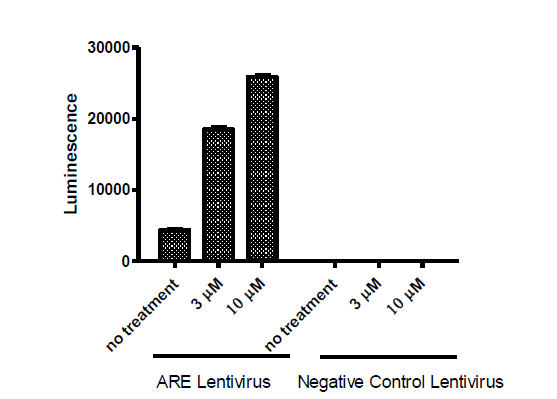79869
ARE Luciferase Reporter Lentivirus
BPS Bioscience
DESCRIPTION
The Nrf2 antioxidant response pathway plays an important role in the cellular antioxidant defense. Nrf2, a basic leucine zipper transcription factor, induces the expression of antioxidant and phase II enzymes by binding to the ARE (antioxidant response element) region of the gene promoter. Under basal conditions, Nrf2 is retained in the cytosol by binding to the cytoskeletal protein Keap1. Upon exposure to oxidative stress or other ARE activators, Nrf2 is released from Keap1 and translocates to the nucleus, where it can bind to the ARE, leading to the expression of antioxidant and phase II enzymes that protect the cell from oxidative damage. The ARE Luciferase Reporter Lentivirus are replication incompetent, HIV-based, VSV-G pseudotyped lentiviral particles that are ready to be transduced into almost all types of mammalian cells, including primary and non-dividing cells. The particles contain a firefly luciferase gene driven by ARE located upstream of the minimal TATA promoter. After transduction, activation of the Nrf2 antioxidant response pathway in the target cells can be monitored by measuring the luciferase activity.
DETAILS
- Notes: Biosafety: The lentiviruses are produced with the third generation SIN (self-inactivation) lentivector which ensures self-inactivation of the lentiviral construct after transduction and integration into the genomic DNA of the target cells. None of the HIV genes (gag, pol, rev) will be expressed in the transduced cells, as they are expressed from packaging plasmids lacking the packing signal. Although the pseudotyped lentiviruses are replication-incompetent, they require the use of a Biosafety Level 2 facility. BPS recommends following all local federal, state, and institutional regulations and using all appropriate safety precautions
- Shiptemp: -80°C (dry ice)
- Synonyms: ARE cell line, Nrf2 reporter, Nrf, Hepg2, ARE, HIV-based, VSV-G
- Warnings: Avoid repeated freeze/thaw cycles.
- Category: Cell Line/Lentiviruses
- Description: The Nrf2 antioxidant response pathway plays an important role in the cellular antioxidant defense. Nrf2, a basic leucine zipper transcription factor, induces the expression of antioxidant and phase II enzymes by binding to the ARE (antioxidant response element) region of the gene promoter. Under basal conditions, Nrf2 is retained in the cytosol by binding to the cytoskeletal protein Keap1. Upon exposure to oxidative stress or other ARE activators, Nrf2 is released from Keap1 and translocates to the nucleus, where it can bind to the ARE, leading to the expression of antioxidant and phase II enzymes that protect the cell from oxidative damage. The ARE Luciferase Reporter Lentivirus are replication incompetent, HIV-based, VSV-G pseudotyped lentiviral particles that are ready to be transduced into almost all types of mammalian cells, including primary and non-dividing cells. The particles contain a firefly luciferase gene driven by ARE located upstream of the minimal TATA promoter. After transduction, activation of the Nrf2 antioxidant response pathway in the target cells can be monitored by measuring the luciferase activity.
- Formulation: The lentiviruses were produced from HEK293T cells in the medium containing 90% DMEM + 10% FBS.
- Supplied As: Two vials (500 µl x 2) of ARE luciferase reporter lentivirus at a titer 1 x 107 TU/ml. The titer will vary with each lot; the exact value is provided with each shipment.
- Unspsc Code: 41106621
- Unspsc Name: Virus mediated expression vectors or kits
- Applications: • Screen for activators or inhibitors of the Nrf2 antioxidant response pathway in the transduced target cells • Generation of ARE Luciferase Reporter stable cell line
- Product Type: Lentivirus
- Biosafety Level: BSL-2
- Related Products: 60513, 60514, 60690, 79665
- Storage Stability: Lentiviruses are shipped with dry ice. For long term storage, it is recommended to store the virus at -80°C. Titers can drop significantly with each freeze/thaw cycle.
- Scientific Category: Cell Signaling Pathway
- Instructions for Use: See assay protocol for detailed instructions.
